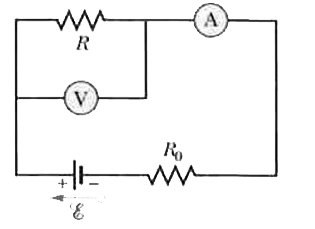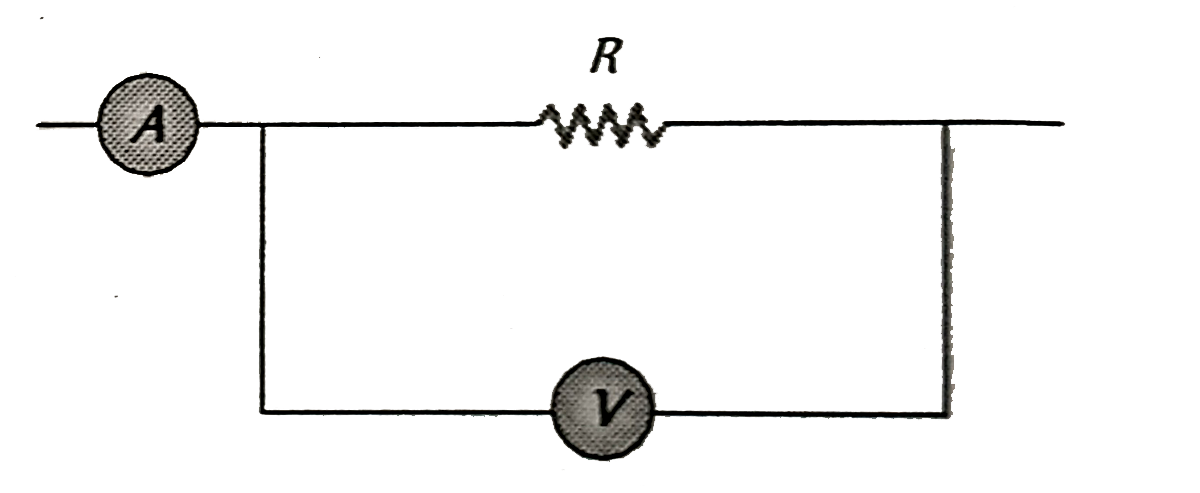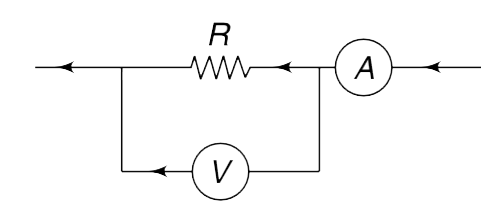In Fig. 27-39, a voltmeter of resistance Rv=300Ω and ammeter of resistance RA=3.00Ω are being used to measure a resistance R in a circuit that also contains a resistance R0=100Ω and an ideal battery with an emf of ε=18.0V. Resistance R is given by R =V/i, where V is the potential across R and i is the ammeter reading. The voltmeter reading is V', which is V plus the potential dilference across the ammeter. Thus, the ratio of the two meter readings is not R but only an apparent resistance R' -V/i. If R =85.0Ω what are (a) the ammeter reading. 
(b) the voltmeter reading, and (c) R'? (a) If RA is decreased, does the difference between R' and R increase, decrease, or remain the same?
The correct Answer is:(a) 0.828 A; (b) 7.29 V; (c) 88.0Ω (d) remain the same
Related Playlists
- BOOK - RESNICK AND HALLIDAYCHAPTER - CIRCUITSEXERCISE - Practice Questions (Single Correct Choice Type)33videos
CIRCUITS
- BOOK - RESNICK AND HALLIDAYCHAPTER - CIRCUITSEXERCISE - Practice Questions (More than One Correct Choice Type)12videos
CIRCUITS
- BOOK - RESNICK AND HALLIDAYCHAPTER - CIRCUITSEXERCISE - Checkpoints7videos
CIRCUITS
- BOOK - RESNICK AND HALLIDAYCHAPTER - CENTER OF MASS EXERCISE - Practice Questions (Integer )4videos
CENTER OF MASS
- BOOK - RESNICK AND HALLIDAYCHAPTER - CIRCULAR MOTIONEXERCISE - CHECK POINTS6videos
CIRCULAR MOTION
Similar Questions
In Fig 27-53, a voltmeter of resistance Rv=300Ω and an ammeter of resistance RA=3.00Ω are being used to measure a resistance R in. a circuit that also contains a resistance R0=100Ω and an ideal battery of emf ε=28.5V. Resistance R is given by R=V//i where V is the voltmeter reading and i is the current in resistance R. However, the ammeter reading is not i but rather i', which is i plus the current through the voltmeter. Thus, the ratio of the two meter readings is not R but only an apparent resistance R'=V/I'. If R=85.0Ω what are (a) the ammeter reading. (b) the voltmeter reading, and (c) R' (d) If Rv is increased does the difference between R' and R increase, decrease or on the same?
 View Solution
View SolutionA voltmeter of resistance RV and an ammeter of resistance RA are connected in a circuit to measure a resistance R as shown in figure. The ratio of the meter readings gives an apparent resistance R′. Show that R and R′ are related by the relation
1R=1R′−1RV
 View Solution
View SolutionA voltmeter and an ammeter are connected in series to an ideal cell of emfE. The voltmeter reading is V, and the ammeter readings is I. Then
(i) V<E (ii) the voltmeter resistance is V/I
(iii) the potential difference across the ammeter is E−V
(iv) Voltmeter resistance + ammeter resistance = E//I
Correct statements areView SolutionA voltmeter and an ammeter are connected in series to an ideal cell of emfE. The voltmeter reading is V, and the ammeter readings is I. Then
(i) V<E (ii) the voltmeter resistance is V/I
(iii) the potential difference across the ammeter is E−V
(iv) Voltmeter resistance + ammeter resistance = E//I
Correct statements areView SolutionThe battery of EMF 5V and internal resistance 20Ωis connected with a resistance R1=50Ω and a resistance . A voltmeter of resistance 1000Ω is used to measure the potential difference across R1 .What percentage error is made in the reading.
View SolutionThe ammeter A reads 2A and the voltmeter V reads 20V, the value of resistance R is (Assuming finite resistance's of ammeter and voltmeter)
 View Solution
View SolutionThe ammeter A reads 2A and the voltmeter V reads 20V, the value of resistance R is (Assuming finite resistance's of ammeter and voltmeter)
 View Solution
View SolutionA voltmeter of resistance RV and an ammeter of resistance RA are connected as shown in an attempt to measure the resistance R. The measured value of the resistance is RM=VI0 where V is reading of voltmeter and I0 is reading of the ammeter. find the true value of the resistance in terms of RM,RVandRA.
 View Solution
View SolutionIf resistance of voltmeter is 10000Ω and resistance of ammeter is 2Ω then find R when voltmeter reads 12 V and ammeter reads 0.1 A
View SolutionA 100V voltmeter having an internal resistance of 20kΩ is connected in series with a large resistance R across a 110V line. What is the magnitude of resistance R if the voltmeter reads 5V?
View Solution

